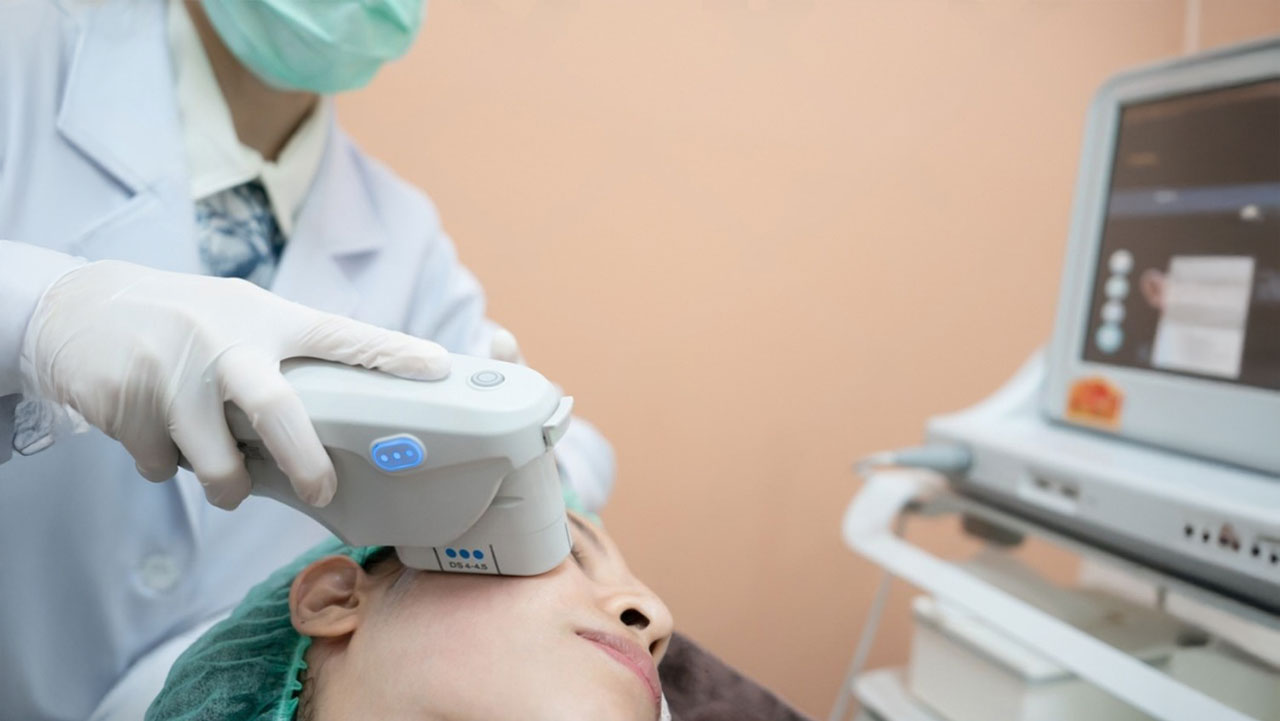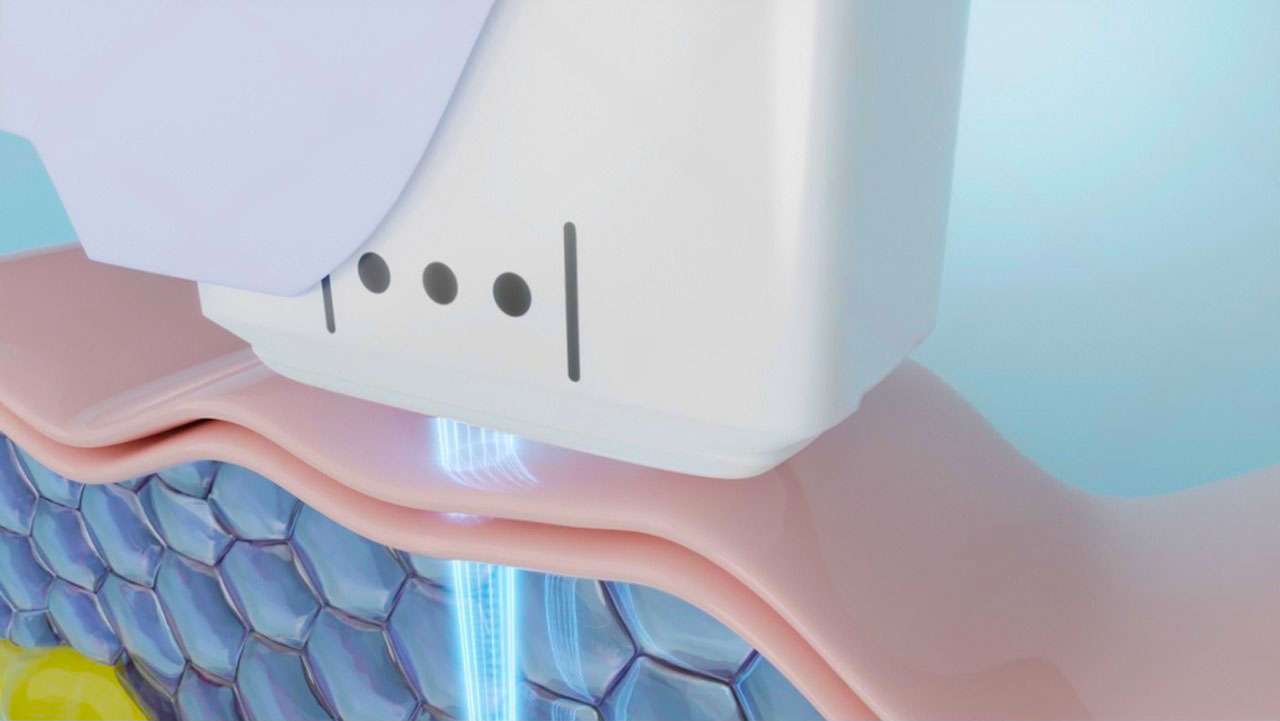What is Ulthera?
Ulthera is a skin-tightening technology that utilizes high-frequency ultrasound waves to deliver targeted heat energy to the deep layers of the skin. This heat causes the tissue to contract and stimulates the production of new, fresh collagen. The procedure is non-surgical, requires no needles, and has minimal to no downtime, making it a convenient option for skin rejuvenation.
The Mechanism of Use
The Ulthera device uses a specialized transducer to deliver focused ultrasound energy beneath the skin’s surface. This energy converts into heat at optimal temperatures of 60-70°C, causing the skin tissue to contract and initiating a natural process called neocollagenesis. A key feature of the Ulthera system is a real-time ultrasound imaging screen, which allows the doctor to visualize the targeted tissue layers and ensure the energy is delivered precisely where it will be most effective, without affecting the surrounding skin.



Treatment Techniques and Targeted Layers
The Ulthera system employs different transducers, each designed to treat a specific depth of the skin, targeting key layers for a comprehensive lifting effect:
5 mm: Targets the epidermis and upper dermis layers, helping to improve fine lines and overall skin texture.
0 mm: Reaches the deep dermis and subcutaneous fat layer, stimulating collagen to lift and tighten areas with more volume, such as around the eyes and forehead.
5 mm: Delivers energy to the Superficial Muscular Aponeurotic System (SMAS), the same foundational layer that surgeons tighten during a traditional facelift. This depth is crucial for achieving a significant lifting effect on the cheeks, jawline, and neck.
Step-by-Step Ulthera Procedure
Consultation: The procedure begins with a consultation where a certified specialist assesses your skin, discusses your aesthetic goals, and determines if Ulthera is the right treatment for you. A personalized treatment plan is created, outlining the areas to be treated and the number of “lines” of energy required.
Preparation: On the day of the procedure, your skin will be thoroughly cleansed to remove any makeup, oils, or residue. A special ultrasound gel is then applied to the treatment area to ensure the transducer can glide smoothly and that the ultrasound waves are transmitted effectively.
Visualization and Planning: The practitioner uses the Ulthera machine’s real-time imaging screen to visualize the deep layers of your skin and confirm the specific depth and location for energy delivery. This step is crucial for precision and safety, allowing the doctor to target the SMAS layer or other specific depths accurately.
Energy Delivery: The doctor places the Ulthera transducer on the skin and begins delivering controlled, focused ultrasound energy. You may feel a series of small, deep heat sensations as the energy is delivered to the targeted tissue. The doctor will adjust the transducer and energy levels as they move across the treatment area, ensuring even and consistent coverage.
Completion: Once the planned treatment area has been covered, the doctor removes the transducer and cleans off the ultrasound gel. The entire procedure typically takes between 30 and 90 minutes, depending on the size of the area being treated.
Post-Treatment Care: You can immediately resume your normal activities. The doctor and nurses will provide you with aftercare instructions, such as avoiding excessive heat and direct sun exposure and continuing to use sunscreen. Any minor redness or swelling that occurs will typically resolve on its own within a few hours to a few days.
Ulthera Models and Their Differences
Two primary models are recognized: Ulthera SPT and Ulthera Prime. While both use the same foundational micro-focused ultrasound technology to achieve skin lifting and collagen stimulation, the specifics of their differences are often related to technological advancements and user interface improvements in newer generations (Prime), which aim to enhance precision and the patient experience. The core principle of lifting the SMAS layer remains a key feature in both.
| Feature | Ulthera SPT | Ulthera Prime |
| Technology | Standard micro-focused ultrasound with visualization (MFU-V) | Enhanced micro-focused ultrasound with visualization (MFU-V) |
| Speed | Standard processing speed for energy delivery and visualization. | Faster processing (up to 20% faster), leading to shorter treatment times. |
| Visualization | Standard screen size and resolution for real-time imaging of skin layers. | Larger display screen (up to 35% larger) with enhanced resolution for clearer, more precise imaging. |
| Patient Comfort | May cause a more intense deep heat sensation or discomfort during the procedure. | Designed with improved technology to reduce discomfort and offer a more comfortable experience. |
| User Interface | Standard user interface. | Modern, intuitive graphical user interface with an improved ergonomic design. |
| Results | Effective for lifting and tightening. | Offers superior precision and more uniform energy delivery, potentially leading to more noticeable and longer-lasting results. |
What to Expect
Preparation for Treatment
To prepare for your Ulthera procedure, it is recommended to:
Avoid sun exposure and tanning for at least two weeks before the appointment.
Discontinue blood-thinning medications like NSAIDs (Aspirin, Ibuprofen), fish oil, and vitamin E supplements one week before the procedure to reduce the risk of bruising.
Avoid certain skincare products containing ingredients like retinol or glycolic acid in the week leading up to the treatment.
Arrive without makeup in the treatment area.
During the Procedure
A typical Ulthera session lasts between 30 and 90 minutes, depending on the treated area. The doctor applies a special ultrasound gel to the skin and uses the transducer to deliver the energy. You may feel a brief sensation of deep heat or tingling, which indicates that the collagen-building process has been activated. The discomfort level is generally described as tolerable.
After Ulthera Care
There is no significant downtime after an Ulthera treatment, and you can resume your normal activities immediately.
You may experience mild redness or swelling, which typically subsides within a few hours to a few days.
Avoid hot baths, saunas, and strenuous exercise for 24 hours after the procedure.
Protect your skin from the sun and use a high-SPF sunscreen regularly.
Swelling and Recovery
While most people experience no significant downtime after Ulthera, a common side effect is mild swelling. This post-procedure swelling typically begins to subside within a few days, with most patients seeing it completely resolve within a week. The pace of recovery depends on individual factors, but the process is generally swift and allows for a quick return to daily life.
Seeing Your Results
The beauty of Ulthera lies in its gradual and natural-looking results. You may notice a subtle initial lift right after the treatment, but the full effects unfold over time. The body’s natural collagen production takes 2-3 months to fully develop, and this is when the most noticeable improvements, such as tighter, firmer skin and a more defined jawline, become apparent. The benefits can continue to improve for up to six months, with results lasting a year or more.
Can Ulthera be performed with other procedures?
Ulthera is an excellent foundation for a comprehensive anti-aging plan. It can be safely and effectively combined with other cosmetic procedures, such as:
Dermal fillers: To restore lost volume in the cheeks or lips.
Botox injections: To address dynamic wrinkles and fine lines.
Microneedling and laser treatments: To improve skin texture and tone.
When combining treatments, it’s often recommended to perform Ulthera first and then follow up with other procedures to achieve the best synergistic results. Always consult with a qualified dermatologist or aesthetic practitioner to create a personalized treatment plan.
FAQ
Some patients feel mild to moderate discomfort, but numbing cream and oral pain relievers help minimize this.
Most patients require only 1 session. Annual maintenance may be recommended.
Yes, Ulthera is safe for all Fitzpatrick skin types since it doesn’t affect the outer skin.
Ideal for individuals aged 30–60 years with mild to moderate skin laxity.


